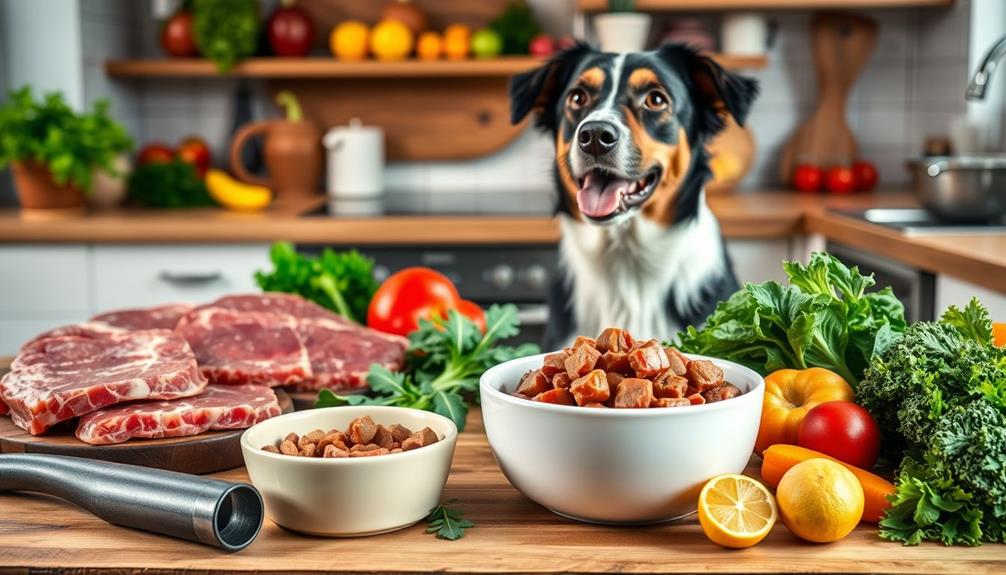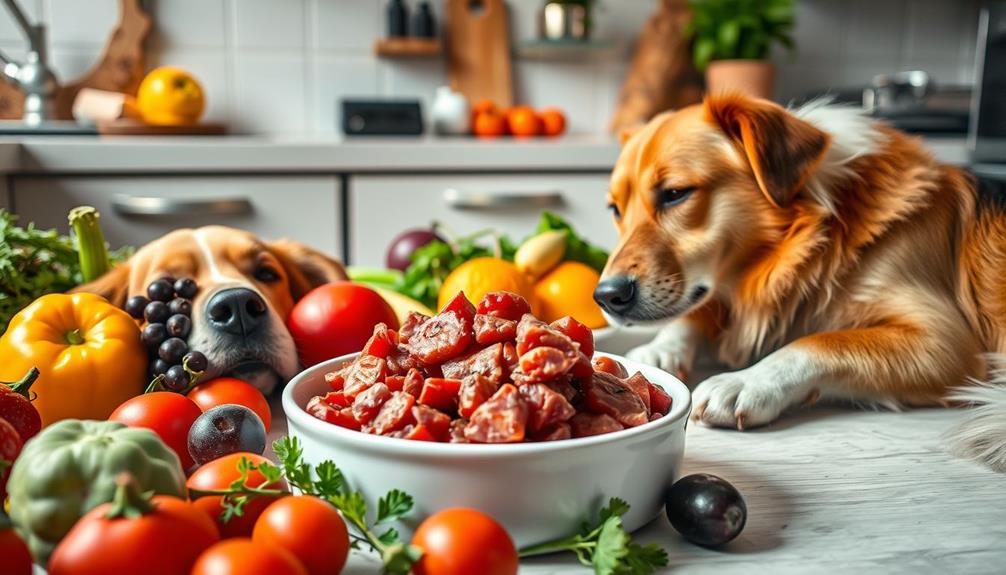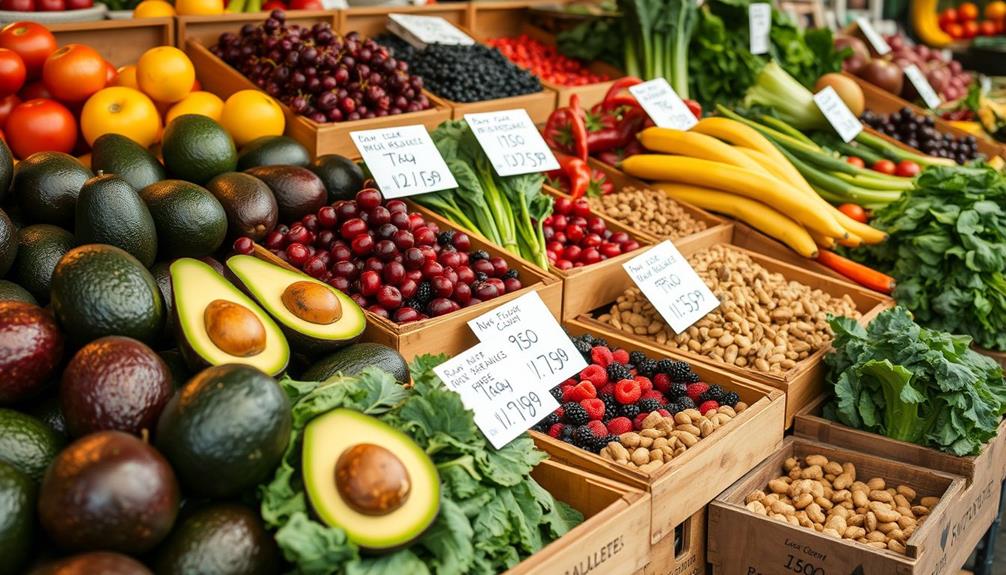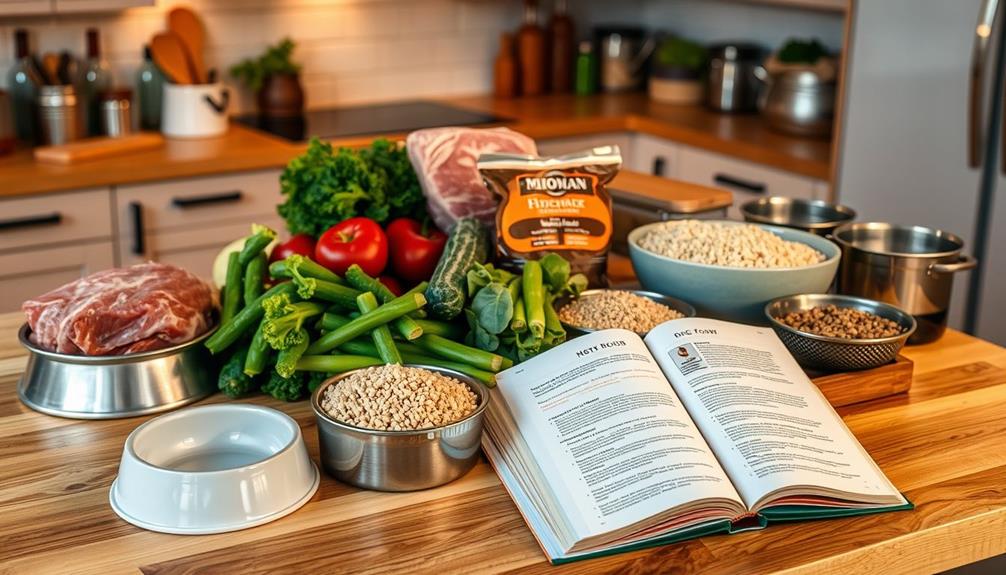To start a raw food diet for your dog, focus on an 80% meat base with 20% from bones and organ meats. Choose high-quality, unprocessed meats and handle them safely to avoid contamination. Shift gradually over 7-10 days, monitoring your dog's stool for adjustment. Tailor portions based on breed size and activity level; small dogs need about 5 ounces daily, while larger breeds require 2-3% of their body weight. Don't forget to account for special needs if you have pregnant or senior dogs. There's plenty more to reflect on, so keep exploring for the best practices and tips!
Key Takeaways
- A balanced raw dog diet typically consists of 80% meat, 10% edible bone, and 10% organ meats, including liver.
- Gradually transition to raw food over 7-10 days, monitoring stool consistency and adjusting based on sensitivity.
- Maintain hygiene by washing hands, cleaning surfaces, and using separate cutting boards for raw meat and other foods.
- Monitor specific dietary needs for pregnant and senior dogs, increasing protein intake and adjusting portions as necessary.
- Buy raw ingredients in bulk and explore local farms to reduce costs while ensuring high-quality nutrition for your dog.
Understanding Raw Dog Food
Understanding raw dog food means recognizing the benefits of a diet that emphasizes uncooked ingredients, primarily raw meat, organs, and bones. This approach often includes optional fruits and vegetables to create a balanced raw diet. Many pet owners believe that feeding raw food for dogs can lead to shinier coats, healthier skin, and increased energy levels. In addition, the natural enzymes found in raw meat can aid in digestion, and the chewing of raw bones can help to keep teeth clean and strong. However, it is important to consult with a veterinarian before transitioning to a raw food for dogs diet to ensure that it is properly balanced and meets all of your pet’s nutritional needs.
Your dog's digestive system is uniquely equipped to handle raw meat, featuring strong stomach acid and digestive enzymes that help break down these foods safely. Additionally, incorporating a variety of proteins can enhance nutritional diversity and support overall health; for example, ultimate hamster care guide can provide insights into the importance of balanced diets.
A balanced raw diet typically consists of 80% meat, 10% edible bone, 5% liver, and 5% other organ meats. This ratio guarantees your dog receives essential nutrients for peak health.
When selecting raw dog food, focus on high-quality ingredients from reputable sources. Avoid processed meats that might contain harmful additives, as they can undermine the health benefits of a raw diet.
Proper handling is vital when feeding your dog raw food. Always wash your hands and clean surfaces after handling raw meat to minimize contamination risks.
Adhering to a reliable feeding guide can also help you confirm that your dog gets the right balance of nutrients. By committing to these practices, you'll set the stage for a healthy lifestyle for your furry friend.
Benefits of a Raw Diet

A raw diet for dogs offers numerous benefits that can greatly enhance your pet's overall health and well-being. Shifting to a raw diet can lead to healthier skin and improved coat condition, as the natural fats and moisture in raw foods promote shiny coats. You'll likely notice these changes shortly after making the switch.
Additionally, a raw diet promotes better digestion. Dogs often produce smaller, firmer stools due to the efficient absorption of nutrients compared to processed kibble. This improved digestion can also contribute to reduced health issues over time, including chronic diseases and allergies.
Many dog owners report increased energy levels after changing to raw feeding. This boost comes from the nutrient-dense, high-quality ingredients, such as muscle meat, organs, and bones, which provide essential vitamins and minerals.
Here's a quick overview of the benefits of a raw diet:
| Benefits of Raw | Description | Impact on Dogs |
|---|---|---|
| Healthier Skin | Natural fats promote skin health | Shiny, vibrant coats |
| Better Digestion | Smaller, firmer stools | Improved nutrient absorption |
| Nutritional Benefits | High-quality ingredients | Increased energy levels |
Safety and Hygiene Practices

Switching to a raw food diet can greatly benefit your dog's health, but it's crucial to prioritize safety and hygiene practices to keep your pet healthy.
Start by implementing safety precautions when handling raw meat. Always wash your hands, clean utensils, and surfaces thoroughly with hot, soapy water to prevent cross-contamination. Use separate cutting boards for raw meat and other food items. Additionally, consider the importance of potential side effects and interactions that may arise from improper food handling.
To store raw dog food, keep it in the freezer to avoid spoilage and thaw it in the refrigerator. This practice minimizes bacterial growth and preserves the food's nutritional value. Always check expiration dates on raw meat products and discard any that show signs of spoilage, such as off odors or discoloration.
After your dog eats, monitor the eating area for leftover raw food or juices. Clean up promptly to avoid attracting pests and reduce contamination risk.
Additionally, make it a habit to regularly clean feeding bowls with hot, soapy water to maintain hygiene. By following these practices, you can guarantee a safe and healthy raw food experience for your furry friend.
Transitioning to Raw Food

When you're ready to shift your dog to a raw food diet, it's essential to do it gradually over 7-10 days.
Starting with a mix of 25% raw food and 75% of their current diet can help ease the change, while also monitoring for any signs of discomfort.
Pay close attention to their stool consistency to confirm they're adapting well, as this can indicate how well they're handling the new food.
Additionally, understanding the importance of financial considerations for elderly care can aid in budgeting for any necessary supplements or veterinary visits during this shift.
You may need to adjust their food based on their health and any signs of sensitivity during this process.
Gradual Transition Process
Changing your dog to a raw food diet requires a careful and gradual approach to guarantee their digestive system adjusts smoothly.
Start the changeover by mixing 25% raw food with 75% of their current diet for the first three days. This gradual changeover helps ease your dog into the new food, similar to how one might use essential oils for toothache relief during a shift in routine.
After this, shift to a 50/50 mix for the next three days, and then increase it to 75% raw and 25% of the old diet for another three days. By Day 10, aim to fully switch to the raw food diet, ensuring your dog has adapted well throughout the process.
During this changeover period, it's important to monitor stool consistency. You should aim for balanced stools that aren't too loose or too firm.
For sensitive dogs or those coming from highly processed diets, consider extending the changeover period to 10-14 days. This extra time can help prevent digestive upset and allow their digestive system to adjust more comfortably to the raw food.
Monitoring Dietary Adjustments
Monitoring your dog's dietary adjustments during the shift to a raw food diet is essential for guaranteeing their health and well-being. Start by closely observing your dog's stool consistency; balanced stools should neither be too loose nor too firm. This helps gauge how well your dog is adapting during the change phase.
Additionally, incorporating regular check-ups will provide insights into your dog's overall health during this adjustment. Keeping a food diary is also important. It allows you to track changes in your dog's health, behavior, or reactions to specific ingredients, helping you identify any potential allergies or sensitivities.
Adjust portion sizes based on your dog's weight and activity level. Begin with about 2% of their ideal body weight daily and gradually increase it based on their response. Regular health check-ups are significant throughout this period to assess your dog's nutritional requirements and guarantee the raw food diet is meeting their specific needs.
Be prepared for possible detox symptoms, like mild gastrointestinal upset, as your dog sheds toxins from processed foods. These symptoms are typically temporary, but monitoring them closely will help you determine when to consult your vet for further guidance.
Feeding Guidelines by Breed

Understanding your dog's breed is vital for providing the right raw food diet tailored to their specific needs. Feeding guidelines vary greatly based on breed size and life stage, and it's important to take into account factors like credit score when evaluating your financial capacity to provide the best nutrition for your pet.
For small breeds (15 lbs or less), you should aim for about 5 ounces of raw food daily, while puppies in this group may need up to 8 ounces to support their growth.
Medium breed seniors often require 50% more protein to combat muscle mass loss, so adjust their diet accordingly to maintain health and weight.
For large breeds (70 pounds or more), their daily intake should be around 2-3% of their body weight in raw food, with puppies needing a hefty 50-60% of their body weight in ounces for proper growth.
The recommended daily intake for adult dogs usually falls between 2-5% of their body weight, but this can vary based on individual health and activity levels.
It's essential to monitor and adjust these amounts based on breed size and life stage to guarantee balanced nutrition and overall well-being.
Special Needs for Pregnant and Senior Dogs

When you're caring for pregnant or senior dogs, their nutritional needs shift notably.
Pregnant dogs require increased food intake, especially in the third trimester, as their bodies are undergoing rapid changes to support the growing puppies.
Additionally, senior dogs face unique challenges, including potential digestive issues and reduced activity levels, making it important to monitor their diet closely.
It's crucial to stay vigilant about their diet and consult your vet for tailored advice, especially regarding key domains of development that may affect their overall health and well-being.
Nutritional Adjustments for Seniors
As your dog ages or becomes pregnant, their nutritional needs shift considerably, requiring careful adjustments to their diet. For senior dogs, you might need to increase their protein intake by up to 50% to help combat muscle mass loss and support overall health.
However, it's essential to practice portion control to prevent obesity, which can exacerbate health issues like arthritis. Additionally, senior dogs often experience chronic feelings of emptiness or emotional instability, similar to individuals with Borderline Personality Disorder, making it important to reflect on their emotional well-being alongside their physical health.
Maintaining a proper nutritional balance is imperative. Adjust their raw food intake based on their health status and activity level. If your senior dog suffers from conditions like arthritis or diabetes, think about working closely with your vet to meet their specific dietary needs.
Regular vet check-ups are fundamental for monitoring their health and ensuring they're receiving the right nutrients without any deficiencies.
Always be mindful of how your senior dog responds to dietary changes. Monitor their weight and energy levels, and be ready to make further adjustments.
A tailored approach will help keep your senior dog healthy and happy, allowing them to enjoy their golden years comfortably. Remember, you're their best advocate in managing their nutritional needs!
Dietary Needs for Pregnant Dogs
Pregnant dogs have unique dietary needs that require careful attention to guarantee both their health and the health of their puppies. To assure your dog thrives during pregnancy, feed your dog a diet consisting of approximately 80% meat, 10% edible bone, and 10% organ meat, while limiting liver to no more than 5% of the total diet.
During the first two trimesters, maintain their regular diet, but increase food intake by 5-10% in the third trimester to support milk production. Monitor their weight in raw food closely, as excessive weight gain can lead to health issues. Adjustments should be based on their body condition.
In the table below, you can see the key components of a complete and balanced diet for pregnant dogs:
| Component | Percentage |
|---|---|
| Meat | 80% |
| Edible Bone | 10% |
| Organ Meat | 10% |
| Liver | ≤ 5% |
| Increase in Intake | 5-10% (3rd trimester) |
Special considerations for senior dogs include higher protein and fat needs, often requiring up to 50% more protein during pregnancy.
Monitoring Health and Weight
Monitoring the health and weight of your dog is essential, especially for pregnant and senior dogs. For pregnant dogs, it's important to maintain a balanced diet during the first two trimesters, but you'll need to increase their food intake by 5-10% in the third trimester to support their energy needs for milk production.
Additionally, incorporating gentle exercises and stretching can help maintain their overall health during pregnancy, similar to yoga for back pain, which promotes relaxation and well-being. After delivery, continue to adjust their diet based on litter size for at least four weeks.
Senior dogs, particularly medium and large breeds, require extra attention. They may need up to 50% more protein to counteract muscle mass loss and should be regularly monitored for health issues like obesity and arthritis.
A balanced diet tailored to their weight and activity level is important for preventing complications associated with aging.
Regular vet check-ups are key for both pregnant and senior dogs. These check-ups help you track any changes in weight, coat condition, and overall well-being, ensuring that your dog's dietary needs are adequately met.
Cost-Saving Strategies for Raw Feeding

Feeding your dog a raw food diet doesn't have to break the bank; with a few smart strategies, you can keep costs down while providing high-quality nutrition. Start by buying raw meats in bulk and freezing them in portions. This approach allows you to take advantage of discounts at local butchers or wholesale suppliers. If you’re concerned about the variety of meats available, there are plenty of raw food recipes for dogs that incorporate a range of proteins such as chicken, beef, and fish. Additionally, consider sourcing fruits and vegetables from local farmers’ markets or growing them in your own garden to add nutrients and fiber to your dog’s diet. By being proactive and resourceful in your approach to feeding your dog a raw food diet, you can ensure their health and well-being without breaking the bank.
Additionally, consider exploring different investment options for your pet's nutritional needs, such as purchasing raw ingredients from trusted suppliers that offer competitive pricing. Look for lower prices on cheaper cuts of meat, organ meats, and meaty bones, which provide essential nutrients without the premium price tag.
Meal planning is vital for budgeting for pet food. Create a shopping list to avoid impulse purchases and guarantee you only buy what's necessary.
Also, consider engaging with local farms or farmers' markets, where you might find high-quality meats at lower prices.
Another option is exploring raw dog food subscription services, which often offer savings compared to in-store prices and provide the convenience of regular deliveries tailored to your dog's nutritional needs.
With these cost-effective raw feeding strategies, you can maintain a healthy diet for your dog without straining your budget.
Frequently Asked Questions
What Are the Guidelines for Raw Food Diet for Dogs?
For a raw food diet, aim for 80% meat, 10% edible bone, 5% liver, and 5% organ meat. Start gradually over 7-10 days, monitor your dog's health, and adjust based on their needs.
How Do I Start My Dog on a Raw Diet?
Isn't it exciting to contemplate a raw diet for your dog? Start by mixing 25% raw food with their current diet, gradually increasing to 100% over ten days while monitoring their stool consistency.
What Is a Complete Raw Diet for Dogs?
A complete raw diet for dogs includes 80% meat, 10% edible bone, 5% liver, and 5% other organs. This balance guarantees your dog gets essential nutrients for peak health and vigor. Variety is key!
How to Make Complete Raw Dog Food?
When you're crafting complete raw dog food, balance 80% meat, 10% edible bone, 5% liver, and 5% other organs. Rotate proteins and add fruits and veggies for a nutritious, tasty meal your pup'll love!
Conclusion
By embracing a raw food diet for your dog, you're opening the door to a world of vibrant health and happiness. Picture your furry friend, full of energy, bounding through the grass like a gazelle, all thanks to the nourishment you provide. As you navigate this journey together, remember that each meal is a step towards a stronger bond and a healthier life. So, take the plunge, and watch your pup thrive like a blooming flower in the sun.










